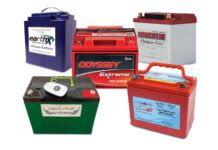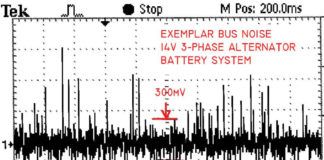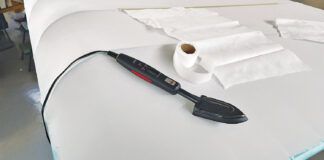Last month we went through battery basics and saw that different requirements translate into different hardware. Wed been trying to find an approach to this subject for a couple of months when we were contacted by Bill Woods of VDC Electronics with an offer to assist in a piece on battery chargers and how they relate to aviation batteries. He was enthusiastic about a new charger the company had developed specifically for aviation and wanted to tell us about it.
Sensing an opportunity for some new information, we continued the conversation. For the sake of objectivity we also contacted representatives at Concord and Odyssey, and then spent the day at a Teledyne Battery 101 class. Teledyne is the maker of Gill batteries. It soon became apparent that this was really two stories, one about batteries and another about battery chargers.
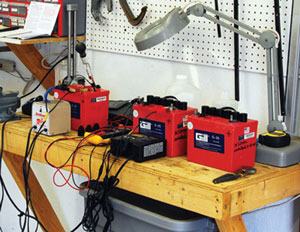
The lab. Not seen is the computer for logging the data or the temperature compensated hydrometer for measuring the specific gravity. At far left is what was thought to be a safe 1-amp charger. The black box is the Battery Minder from VDC; the yellow box is the digital voltmeter.
Comparison Shopping
If you have a decent voltmeter, Id suggest you check the output of your charger. You might be as surprised as I was to find your assumptions wrong. I have six chargers in and around the shop, so I decided to compare them.
Number one is a 1-amp motorcycle battery charger. A check with the voltmeter showed it was putting out 14.2 volts at a constant 1 amp.
Number two is a fairly new auto battery charger with a row of LEDs showing the variable amperage; it put out only 11.6 volts.
Numbers three and four are from the same manufacturer and came in at 13.2 volts with variable amperage. Number five is an older car charger, but it put out a measly 11.3 volts and variable amperage. Number six pushed 14.7 volts with variable amperage.
Several months ago I had left number one connected overnight to the battery in my wifes Cessna 172. The next morning I had an acid-etched hole in the concrete floor of the hangar and a destroyed battery! So much for the notion of small equals safe chargers.
You might assume from this experience that the lowest voltage charger with variable amperage would be the safe one. Woods dispelled that notion with the explanation that low voltages promote the formation of sulfates on the plates. Youll recall that these sulfates are a leading cause of battery death. And a charger with insufficient voltage will charge a battery to less than its full potential. So I could toss numbers one, two and five into the trash.
Right now you’re probably thinking, Some people collect stamps and he collects battery chargers…it takes all kinds. No, Im not that weird. Number one was for motorcycles; 40 years ago it made sense. Numbers two and five were for cars in two locations. Numbers three and four are desulfating type chargers used on two airplanes in two locations. Number six is a desulfating charger designed specifically for Odyssey 12-volt batteries. I recite this only to point out that chargers have changed a lot over the years; yours may be more problem than cure.
You Don’t Need No Stinking Sulfates
But does the desulfation aspect work? To answer that I put three used Gill G25 batteries on the bench and tried out charger number four; its aviation specific and brand new. I was less than charged up with the results. However, in fairness, I contacted the manufacturer, VDC, for an explanation. I was satisfied with the answer, but lets first look at the results of the test.
As you can see from the OCV graph (Page 50), this test was continued until no further improvement could be gained. The procedure was to charge for 24 hours, then rest for 24 hours, then test. Therefore, the test lasted 24 days on this one battery. I ran all three batteries through this sequence with this being the typical result. You more electrically minded types will also be interested in the specific gravity of the cells.
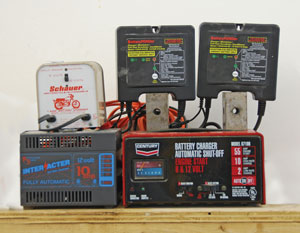
Five chargers and four levels of performance. Note also that the two chargers on the upper right are from BatteryMINDer. One is labeled is the 12248-AA-S3 for Odyssey type batteries, and the other is the S2, for conventional flooded-cell batteries. These chargers are designed for specific applications and, although they will work on, say, your car, for the best battery life the charger should match.
And the Winner Is…
I was using a state-of-the-art charger/desulfator, so I was surprised that this battery did not achieve the minimum 80% required by the FAA. In fact, none of the three Gill G25 batteries I tested hit that mark.
A call to Woods of VDC elicited some probing questions. To my embarrassment, the probing questions were from him. It turns out that not one of my three test batteries was a candidate for sulfation, because they were not just below the mark of 12.6 volts, they were stone cold dead. As Woods explained, Hey, our desulfator is good, but it cant bring back the dead! So much for the hoped for Lazarus effect. (See the sidebar on Page 48 for a synopsis of your chances at resurrecting an old battery.) That initial meteoric rise in OCV and SG did a pretty good job, though, and settled to a level acceptable for my garden tractor.
As far as the performance goes, or the lack thereof, for chargers one, two and five, Woods was adamant that under-charging could be as damaging as over-charging. Sulfates form when a battery is allowed to reside in an under-charged condition, and thats exactly what numbers two and five will do. Number one boiled the electrolyte and warped the plates, so it became an ex-battery as well, just more quickly.
In all fairness, I must say that numbers three, four and six are VDC chargers that were sent to me by Woods. The first two are early and current models of aviation-specific 12-volt chargers, while number six is dedicated to and approved by Odyssey battery.
I found several other desulfators in kit form for less than $50 along with a couple of desulfating chargers. The latter cost more than $1000, and thats a bit out of range for the average kit aircraft builder. The homebuilt version is in test as I write this, so well have more on it later.
The other option for keeping a battery charged is a solar cell. Although some folks swear by them, I cant endorse them for the same reason Im disappointed with three of the plug-in chargers: low voltage. Of course, low voltage input is better than no voltage, but given the cost of aviation batteries that route would appear to be penny wise and pound foolish.
Given the results (see the chart), would I recommend the units from VDC? Id have to say yes, partly in light of the dismal results displayed by those chargers obtained at the auto parts store, and partly because of knowledge gained from a broad range of sources.
Another factor in my thumbs up to the BatteryMINDer from VDC is that its the only charger Ive seen that included a third wire with a ring lug. Said lug sends a temperature reading back to the black box and adjusts the power going to the battery according to the temperature of the battery. The ideal output of 13.1 volts is valid for a battery temperature of 77 F (25 C). Let the battery temp go above 125 F (52 C), and serious damage will be done. So when the battery goes above that 25 C, the sensor sends a signal that throttles back the output 28 millivolts per degree C.
How easy is it go above 125 F in your hangar? Probably not easy, but consider that the Cessna battery I boiled was in the shade on a cool October day. The OAT is just the starting point.
The bottom line is this: It’s easier to keep a battery healthy than to resurrect it. And given the price of a new battery, it’s also likely to be cheaper to buy a good charger than a new battery.
Is Your Battery a Candidate for Desulfation?
In our testing of desulfation we discovered that the dead shall not rise. So how would you know if you should bother to try resurrecting a battery? How good/bad does it have to be to be a candidate for desulfation? Fortunately, this is about the easiest aspect of the entire picture of batteries, chargers and desulfation do-hickeys.
- Disconnect the battery leads. It is essential that there be no loads on the battery.
- Charge the battery to its fullest capacity with a charger that limits the current. Use caution here. Its tempting to use an el-cheapo charger and leave it overnight. That can overheat and destroy the battery.
- Allow the battery to just sit for a minimum of 12 hours.
- Measure the battery’s voltage and record the reading. You’ll need a digital voltmeter ($20 at Radio Shack).
- If there’s more than 12.6 volts on a 12-volt battery or 25.2 volts on a 24-volt battery, your battery is a prime candidate and is likely to recover as much as 80% of its lost capacity.
How to desulfate is another question.
You could simply shock-charge the battery by attaching it to some outrageously high voltage for a short period. Bad idea! That runs a high risk of destroying the battery and is not recommended by any of the manufacturers.
Better idea: Use a high-frequency pulse type desulfator. Leave it connected for a minimum of 72 hours, and then let it rest for 12 hours before retesting. Battery voltage should have increased when compared to the voltage you measured in Step 4. Desulfate for an additional three day-72 hour/12 hour period and test again. If the voltage has increased when measured in the same way as in Step 4, continue desulfating until you no longer measure an increase in the battery’s open circuit voltage (OCV).
If the sulfate has not already caused permanent damage to your battery, you can expect higher cranking amps and longer life from a battery that would not have passed the annual. The FAA requirement is that the battery must have 80% of its maximum OCV.
Note: Although sulfate is by far the major cause of early battery failure and loss of power, it is not the only reason. Vibration can cause structural damage, contamination occurs through the use of non-distilled water, and long-term under or over charging can cause active material on the storage plates to slough off, and it falls to the bottom of the cell, eventually shorting the cells out.
As with our own bodies, prevention beats rehab every time. Keep your battery fully charged at all times, especially during extended periods of non-use, and you wont need to worry about shortened battery life or loss of performance.
-B.F.








